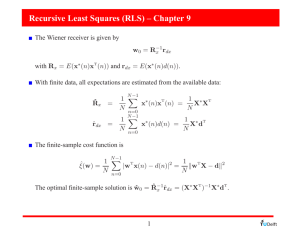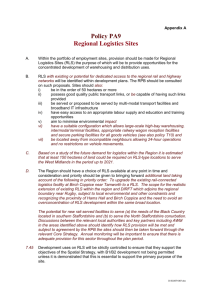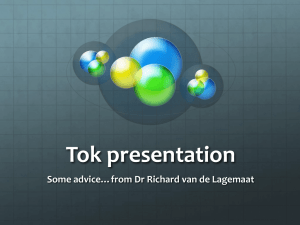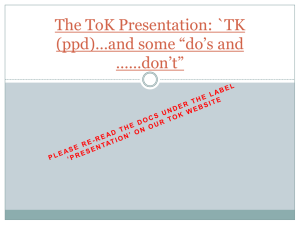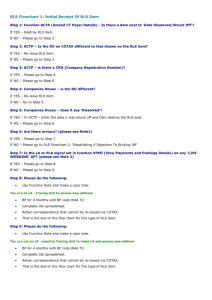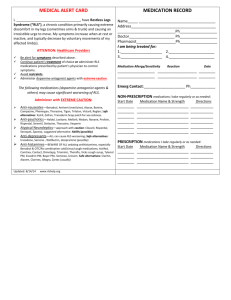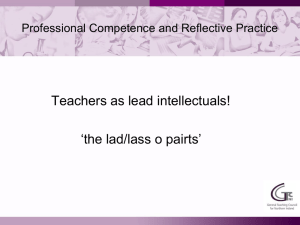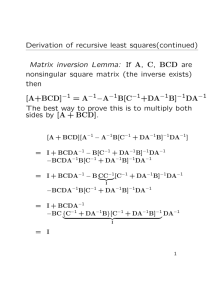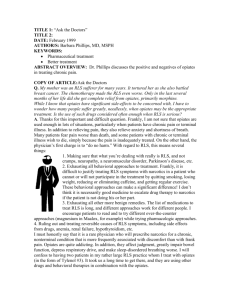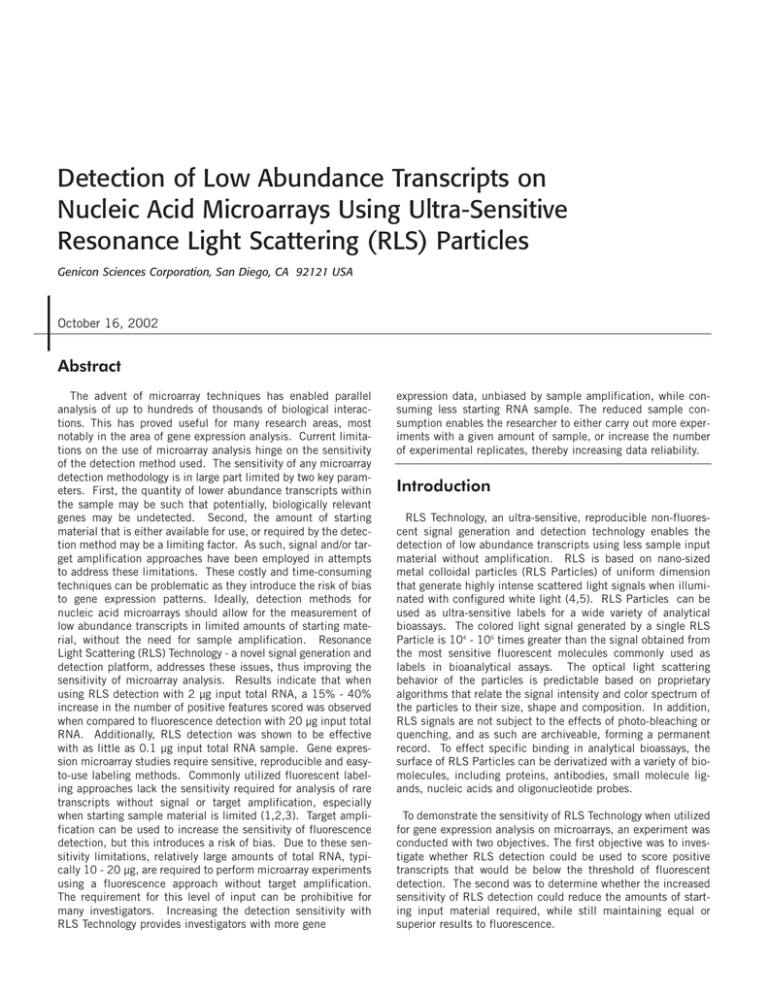
Detection of Low Abundance Transcripts on
Nucleic Acid Microarrays Using Ultra-Sensitive
Resonance Light Scattering (RLS) Particles
Genicon Sciences Corporation, San Diego, CA 92121 USA
October 16, 2002
Abstract
The advent of microarray techniques has enabled parallel
analysis of up to hundreds of thousands of biological interactions. This has proved useful for many research areas, most
notably in the area of gene expression analysis. Current limitations on the use of microarray analysis hinge on the sensitivity
of the detection method used. The sensitivity of any microarray
detection methodology is in large part limited by two key parameters. First, the quantity of lower abundance transcripts within
the sample may be such that potentially, biologically relevant
genes may be undetected. Second, the amount of starting
material that is either available for use, or required by the detection method may be a limiting factor. As such, signal and/or target amplification approaches have been employed in attempts
to address these limitations. These costly and time-consuming
techniques can be problematic as they introduce the risk of bias
to gene expression patterns. Ideally, detection methods for
nucleic acid microarrays should allow for the measurement of
low abundance transcripts in limited amounts of starting material, without the need for sample amplification. Resonance
Light Scattering (RLS) Technology - a novel signal generation and
detection platform, addresses these issues, thus improving the
sensitivity of microarray analysis. Results indicate that when
using RLS detection with 2 µg input total RNA, a 15% - 40%
increase in the number of positive features scored was observed
when compared to fluorescence detection with 20 µg input total
RNA. Additionally, RLS detection was shown to be effective
with as little as 0.1 µg input total RNA sample. Gene expression microarray studies require sensitive, reproducible and easyto-use labeling methods. Commonly utilized fluorescent labeling approaches lack the sensitivity required for analysis of rare
transcripts without signal or target amplification, especially
when starting sample material is limited (1,2,3). Target amplification can be used to increase the sensitivity of fluorescence
detection, but this introduces a risk of bias. Due to these sensitivity limitations, relatively large amounts of total RNA, typically 10 - 20 µg, are required to perform microarray experiments
using a fluorescence approach without target amplification.
The requirement for this level of input can be prohibitive for
many investigators. Increasing the detection sensitivity with
RLS Technology provides investigators with more gene
expression data, unbiased by sample amplification, while consuming less starting RNA sample. The reduced sample consumption enables the researcher to either carry out more experiments with a given amount of sample, or increase the number
of experimental replicates, thereby increasing data reliability.
Introduction
RLS Technology, an ultra-sensitive, reproducible non-fluorescent signal generation and detection technology enables the
detection of low abundance transcripts using less sample input
material without amplification. RLS is based on nano-sized
metal colloidal particles (RLS Particles) of uniform dimension
that generate highly intense scattered light signals when illuminated with configured white light (4,5). RLS Particles can be
used as ultra-sensitive labels for a wide variety of analytical
bioassays. The colored light signal generated by a single RLS
Particle is 104 - 106 times greater than the signal obtained from
the most sensitive fluorescent molecules commonly used as
labels in bioanalytical assays. The optical light scattering
behavior of the particles is predictable based on proprietary
algorithms that relate the signal intensity and color spectrum of
the particles to their size, shape and composition. In addition,
RLS signals are not subject to the effects of photo-bleaching or
quenching, and as such are archiveable, forming a permanent
record. To effect specific binding in analytical bioassays, the
surface of RLS Particles can be derivatized with a variety of biomolecules, including proteins, antibodies, small molecule ligands, nucleic acids and oligonucleotide probes.
To demonstrate the sensitivity of RLS Technology when utilized
for gene expression analysis on microarrays, an experiment was
conducted with two objectives. The first objective was to investigate whether RLS detection could be used to score positive
transcripts that would be below the threshold of fluorescent
detection. The second was to determine whether the increased
sensitivity of RLS detection could reduce the amounts of starting input material required, while still maintaining equal or
superior results to fluorescence.
2
Reverse Transcription
RNA (total or poly(A) + )
Hapten or Dye
incorporation
Denaturation/
RNAse
Hybridization/Wash
RLS Particle
Binding/Wash
Gold RLS Particle with
Anti-biotin Antibodies
RLS Detection
Fluorescence Detection
Figure 1: Illustration of detection of cDNA from reverse transcription of mRNA on nucleic acid detection microarrays via RLS Particle labeling or
fluorescent labeling.
Gene Expression Analysis on Microarrays
Gene expression was measured using labeled cDNA generated
from various input levels (0.1 - 20 µg) of human placenta total
RNA, hybridized to human 1.7K arrays. The arrays were generated by the University Health Network Microarray Centre and
featured 1,728 human PCR amplicons arrayed in duplicate on
Corning GAPS II slides. All experiments were done with 3 - 5
replicate arrays for each label type (biotin, Cy3 and Cy5) and
input level. As arrays were only available in print lots of 70
slides, this study was split into two comparisons, one of RLS vs.
Cy3, and another of RLS vs. Cy5 in order to maintain print lot
specific comparisons between fluorescence and RLS. Antibiotin 80 nm gold RLS Particles were introduced to the RLS
microarray slides post-hybridization to bind to the biotin-labeled
hybridized cDNA. The RLS signals on the microarray slides
were collected as a TIFF image using the white-light/CCD based
GSD-501 RLS Detection and Imaging Instrument. Fluorescent
signals were collected as a TIFF image using the Axon GenePix
4000B laser scanner. Both the RLS and fluorescence experiments were performed in replicates of 10 arrays. Both RLS and
fluorescence TIFF images were analyzed with ArrayVisionRLS
image analysis software using Genicon Sciences’ proprietary
linear normalization feature.
RLS vs. Cy3
Positive Features
#
% of total
RLS Detection of Transcripts not Detected with
Fluorescence
Previous microarray experiments using RLS detection indicated an approximate 10-fold reduction in input sample requirement as compared to fluorescence (data not shown)(6).
Therefore, experimental results from the arrays described above
were compared for RLS detection at an input level of 2 µg total
RNA and at an input level of 20 µg total RNA for fluorescence
detection. Positive features were scored as those with signals
greater than 2.5 times the background (A.Thaliana negative
controls), and are shown in Table 1 below.
RLS detection shows an increase in positive features compared
to both fluorophores, even when using 10-fold less input total
RNA. A 15% improvement (112 additional positives) was seen
in the number of transcripts detected with RLS detection when
compared to Cy3. The increased sensitivity of RLS detection
was even more striking when compared to Cy5, where a 40%
improvement was seen in the number of positives scored (184
additional positives).
RT-PCR was performed to confirm that transcripts scored as
positive by RLS, but negative by fluorescent labels, had been
RLS vs. Cy5
Positive Features
#
% of total
µg)
RLS (2
(2µg)
857
50%
µg)
RLS (2
(2µg)
644
37%
(20 µg)
Cy3 (20µg)
745
43%
(20 µg)
Cy5 (20µg)
460
27%
15%
% Increase of positives (RLS/Cy5)
% Increase of positives (RLS/Cy3)
40%
Table 1. Positive features detected by either RLS, Cy3 or Cy5 on 1.7K human PCR amplicon arrays using 2 µg input total RNA for RLS and 20 µg
total RNA input for both Cy3 and Cy5.
3
accurately scored as positive by RLS. A randomly selected subset of 15 genes (fluorescence negative and RLS positive) were
tested by manual quantitative RT-PCR to establish independent
evidence demonstrating that mRNA from these genes was present in the starting sample. In addition, 10 co-positive genes
(positive for both fluorescence at 20 µg and RLS at 2 µg detection), and 5 co-negative genes (negative for both fluorescence
and RLS detection) were tested as controls. Additionally, both
a -RT and a -template reaction were run as negative controls.
Though the human placenta total RNA was treated with DNase
I prior to purchase, a second DNase I treatment was performed
as an additional precaution to remove any remaining genomic
DNA contamination. The DNase I treated total RNA was then
converted to cDNA using a poly d(T) primer and standard protocols. PCR reactions using gene specific primers and cDNA as a
template were stopped every 5 cycles up to 40 cycles. The PCR
products were separated on gels and quantitated by SYBR green
staining. All 15 genes that were detected by RLS and scored
negative by fluorescence produced measurable single PCR products of expected sizes between the 30th and 40th cycles. Table
2 summarizes these RT-PCR results from the various classes of
genes tested.
Gene Category
Fluorescence + / RLS +
Fluorescence - / RLS +
Fluorescence - / RLS -
Range of 1st PCR Cycle
Detected
20-35
30
35
40
Undetectable up to 40
Number of Genes
Tested
10
1
12
2
5
Table 2: Range of first detectable cycle by quantitative RT-PCR.
The RT-PCR results demonstrate that mRNA transcripts of the
genes tested were present in the original RNA sample and that
the RLS detection results were accurate in scoring these genes
as expressed (i.e. true positive), whereas the fluorescence
results incorrectly assigned those genes as not expressed (i.e.
false negative). Moreover, as seen in Figure 2, the PCR products of the RLS positive genes were first detected at higher
cycle numbers (30 - 40) by RT-PCR than the co-positive genes,
thus suggesting that these targets were present at lower abundance levels, supporting the possibility that RLS detection can
be used to identify lower abundance transcripts undetected by
fluorescence.
RLS Detection with Reduced Amounts of Input Material
To investigate the performance of RLS detection in microarray
experiments when using lower amounts of starting material, the
experimental results from the titrated sample inputs were
examined. The number of positive features scored using RLS
detection was compared to the number of positives scored using
fluorescence detection over an input range of 0.1 - 10 µg total
RNA. As described previously, to ensure that each comparison
of RLS and fluorescence detection was performed within a
single slide print lot, RLS was compared to Cy3 and Cy5 separately. Additionally, a single 0 µg input level was processed as
a negative control for RLS detection.
Representative images of microarrays at the 0.2 µg and 2 µg
total RNA input levels are shown in Figure 3. Both RLS and
fluorescence TIFF images were analyzed using ArrayVisionRLS
Figure 2: Representative RT-PCR results. 5 fluorescence - / RLS +,
1 fluorescence + / RLS +, and 1 fluorescence + / RLS + results are
shown. TIFF images of the corresponding array features and RT-PCR
products from the replicate reactions stopped at 5-cycle intervals are
displayed.
image analysis software to examine the difference in signal to
background across all the features on the microarrays. Figure 4
illustrates the number of positive genes obtained using different
input masses of total RNA. Features were scored as positive
when their signal intensities were measured to be 2.5 times
greater than the mean gene intensity calculated for the 256
A.thaliana negative control features on the arrays. Even at the
10 µg input mass of total RNA, RLS Technology enables the
detection of a significantly higher number of transcripts when
compared to fluorescence. This effect has greater significance
as a lower input mass of total RNA is hybridized to the array.
For example, less than 50% of the genes detected by the
CyDyes at the 10 µg total RNA input levels remain detectable
when 0.5 µg of total RNA is applied to the arrays. By comparison essentially all the genes detected by fluorescence at 10 µg
total RNA input level remain detectable by RLS at the 0.5 µg
total RNA input level. The equivalent input mass was defined
as that amount of input total RNA that resulted in approximately the same number of genes detected as positive by RLS
Technology as was detected by the maximum input of the
respective fluorescent detection method. For detection by Cy3
and Cy5, the measured maximum number of positive features
was estimated from the results obtained at the 10 µg total RNA
input levels. The RNA input level for RLS detection that was
estimated to result in equivalent numbers of positive features
was measured to be 0.5 µg of total RNA. This determination is
consistent with previous observations (data not shown) that the
relative increase in detection sensitivity of RLS over Cy3 and
Cy5 results in at least a 10-fold reduction in starting RNA
requirements. Importantly, the expressed transcripts detected
with Cy3 are always a subset of the larger number of transcripts
detected by RLS. Furthermore, the transcripts detected by RLS
detection at the lower levels of starting material are consistently detected at the higher input levels. This ability to use RLS
with very small amounts of starting material would be particularly advantageous when sample is limited, such as when
dealing with clinical samples or homogeneous cell populations
obtained using laser capture microdissection or fluorescence
activated cell sorting (FACS).
4
RLS
CY5
CY3
2 µg
RNA
0.2 µg
RNA
Figure 3: Image data of Cy3, Cy5 and RLS signal generation and detection on University Health Network, Oncology Gene Expression microarrays
(screen stretch S/B 1 to 10).
Conclusion
# Positives vs. Input Mass - RLS vs. Cy3
# Positives (S/B > 2.5)
1200
1000
800
RLS
Cy3
Equivalence
600
400
200
0
10
5
2
1
0.5 0.2 0.1
Input Mass (µg of Total RNA)
# Positives (S/B > 2.5)
# Positives vs. Input Mass - RLS vs. Cy5
800
700
600
500
400
300
200
100
0
RLS
Cy5
Equivalence
10
5
2
1
0.5 0.2 0.1
Input Mass (µg of Total RNA)
Figure 4: Relative gene positivity rates for a range of input total RNA
for RLS and fluorescence detection on University Health Network 1.7k
human oncology microarrays.
The results of this experiment confirm the increased sensitivity of RLS as compared to fluorescence detection when used for
gene expression microarray analysis. Ultra-sensitive RLS detection enables new, RT-PCR confirmed positives to be detected
that otherwise cannot be seen with either Cy3 or Cy5 even when
using 10-fold less input total RNA with RLS detection. RT-PCR
confirmation also indicated that these transcripts were representative of lower abundance genes. These lower abundance
transcripts that are not detectable on microarrays with either
Cy3 or Cy5, could potentially be biologically relevant genes that
could be studied with RLS detection. Analysis of the sample
input titration results identified that an even greater number of
additional positive transcripts are detected with RLS.
Furthermore, these sample input titration results showed that
the number of positive transcripts detected at 10 µg total RNA
with fluorescence detection can be achieved when using RLS
detection at input levels of only 0.5 µg total RNA. Overall, RLS
Technology is an ultra-sensitive signal generation and detection
method that offers amplification-free analysis of low abundance
transcripts and use of limited amounts of starting material for
application in all gene expression microarray experiments.
Materials and Methods
Arrays
Two separate print lots of human cDNA microarrays containing
3,840 elements printed on Corning GAPS II slides (Corning
Inc., Corning, NY) were purchased from the University Health
Network Microarray Centre (Toronto, Canada). The 3,840 elements consist of 1,728 unique human cDNA clones spotted in
duplicate, 256 elements derived from an Arabidopsis thaliana
cDNA clone for use as negative controls and 128 elements of
3X SSC spotting buffer. The first print lot of microarrays used
in the RLS vs. Cy3 comparison was post-processed by the
5
University Health Network Microarray Centre by UV crosslinking,
washing in 0.1% SDS, and rinsing in DI water and isopropanol
before drying. The second print lot was post-processed at
Genicon Sciences by UV crosslinking only. The arrays were
assayed using the One-Color Microarray Toolkit Protocol
(Genicon Sciences, San Diego, CA).
cDNA Target Labeling and Purification
Reagents:
The following reagents and materials were used to generate
labeled target cDNAs: Total Human Placental RNA (Ambion,
Austin, TX); Superscript II reverse transcriptase, RnaseOUT, 5X
first-strand buffer, 0.1 M dithiothreitol, oligo d(T)(12-18) primers
(Invitrogen, Carlsbad, CA); Cy3 and Cy5 dUTP (Amersham
Pharmacia Biotech, Piscataway, NJ); Biotin-11-dUTP (Enzo
Diagnostics, Farmingdale, NY); sodium hydroxide, Tris-HCl
(Sigma, St. Louis, MO); QIAquick PCR Purification Kit
(QIAGEN, Valencia, CA)
Protocol:
cDNA targets were prepared for each label type by direct incorporation using (per reaction), 7.5 µg total RNA, 0.75 µg oligo
d(T)(12-18) and nuclease free water to 15 µl. The mix was incubated at 70°C for 10 minutes, chilled to 42°C for 2 minutes
before adding reverse transcriptase mix (6 µl, 5X first-strand
buffer; 3 µl, 0.1 M dithiothreitol; 0.9 µl RNaseOUT; 0.6 µl
50XdNTPs (25 mM dATP, DGTP, DCTP, 2.5 mM dTTP in the
case of Cy3 and biotin-labeling reactions, 25 mM dATP, dGTP,
dCTP, 10 mM dTTP in the case of Cy5 labeling reactions); 3 µl,
1mM Biotin-11-, Cy3 or Cy5 dUTP; 1.5 µl SuperScript II) and
then incubated for 60 minutes at 42°C. The reaction was terminated by addition of 5 µl 1N NaOH and incubating for 10
minutes at 70°C, chilled and neutralized with 5 µl 1M Tris-HCl,
pH 7.4. cDNA targets were purified using the QIAquick PCR
Purification Kit using the recommended protocol and eluted
with 50 µl buffer EB.
Pre-Hybridization, Hybridization, and Wash Conditions
70 slides from each batch of microarrays were pre-hybridized
according to the Genicon Sciences One-Color Microarray
Toolkit's Pre-Hybridization Protocol (One-Color Microarray
Toolkit, Genicon Sciences, San Diego, CA). From the first set of
70 slides, 36 were designated for Cy3 detection and 34 for RLS
detection. From the second set of 70 slides, 36 were designated for Cy5 detection and 34 for RLS detection. The slides were
rinsed in DI water and dried under a stream of clean, filtered air.
Cy3 and Cy5 pools of labeled cDNA were divided into samples
representing different input mass amounts (20 µg, 10 µg, 5 µg,
2 µg, 1 µg, 0.5 µg, 0.2 µg and 0.1 µg) of total RNA that were
hybridized to the microarrays according to the Genicon Sciences
One-Color Microarray Toolkit's Hybridization Protocol. Briefly, 3
slides at 20 µg total RNA input, 4 slides at 10 µg total RNA
input, 4 slides at 5 µg total RNA input, 5 slides at 2 µg total
RNA input, 5 slides at 1 µg total RNA input, 5 slides at 0.5 µg
total RNA input, 5 slides at 0.2 µg total RNA input, and 5 slides
at 0.1 µg total RNA input had their respective hybridization mixtures prepared, denatured at 95°C for 5 minutes, and applied
utilizing LifterSlips (Erie Scientific, Portsmouth, NH). The pool
of biotin-labeled cDNA was divided into samples representing
different input mass amounts (10 µg, 5 µg, 2 µg, 1 µg, 0.5 µg,
0.2 µg, and 0.1 µg) of total RNA that were hybridized to the
microarrays according to the Genicon Sciences One-Color
Microarray Toolkit's Hybridization Protocol. Similarly, 4 slides
at 10 µg total RNA input, 4 slides at 5 µg total RNA input, 5
slides at 2 µg total RNA input, 5 slides at 1 µg total RNA input,
5 slides at 0.5 µg total RNA input, 5 slides at 0.2 µg total RNA
input, 5 slides at 0.1 µg total RNA, and 1 slide at 0 µg total
RNA for each of the slide batches had their respective hybridization mixtures prepared, denatured at 95°C for 5 minutes, and
applied utilizing LifterSlips. All slides were incubated at 42°C
for 16 hours in a hybridization chamber, and subsequently
washed according to the Genicon Sciences One-Color Microarray
Toolkit's Post-Hybridization Wash Protocol. The Cy3 and Cy5
labeled slides were rinsed in DI water and dried under a stream
of clean, filtered air.
RLS Particle Binding
RLS Particle Binding was performed according to the Genicon
Sciences One-Color Microarray Toolkit Protocol (Genicon
Sciences, San Diego, CA). Briefly, slides were blocked with RLS
Blocking Solution and then 80 nm gold RLS Particles functionalized with anti-biotin antibodies were added for a 60 minute
binding step. After a brief wash to remove non-specifically
bound RLS Particles, a final rinse in DI water and drying under
a stream of clean, filtered air, the slides were archived by dipping the slides into Archiving Solution.
Array Imaging
Cy3 and Cy5 labeled arrays were read with a GenePix 4000B
scanner (Axon, Union City, CA) at 10 µm resolution, 100%
Laser Power, PMT voltage 700 and 600 volts (Cy3 and Cy5
respectively) to obtain maximal signal intensities at high target
input without signal saturation. Total read time for each slide
was approximately 1.75 minutes. RLS labeled arrays were read
with a white light/CCD-based GSD-501 RLS Detection and
Imaging Instrument (Genicon Sciences, San Diego, CA) at 10
µm resolution and 0.35 second exposure time. The total read
time for each slide was approximately 0.5 minutes. The resulting images were analyzed using ArrayVisionRLS image analysis
software (Genicon Sciences, San Diego, CA, and Imaging
Research Inc., St. Catherines, Canada).
Analysis
ArrayVisionRLS parameters used in the analysis include: MTM
density as the principal measure with a MAD threshold of 6,
spot segmentation enabled, obvious outliers confirmed visually,
flagged, and excluded from analysis. Background was defined
as the average MTM density from the 256 A. thaliana features
on an individual slide (camera bias of 100 subtracted from all
MTM density measures for RLS calculations). A signal to background (S/B) ratio greater than 2.5 was defined as a positively
detected feature. The average number of detected features for
a given input on a given batch of slides was calculated as an
output for comparison between labels.
Quantitative RT-PCR
Human placenta total RNA (Ambion, Austin, TX) was certified
usable in RT-PCR as purchased. The samples of total RNA were
treated a second time in-house with DNase I as an additional
step to remove genomic DNA contamination in the samples by
incubating 14 µg total RNA with 1.5 µl DNase I, 0.5 µl
RNaseOUT and 4 µl 5X first-strand buffer for 15 minutes at
37°C. The reactions were heated to 95°C for 5 minutes to stop
the reaction. An aliquot of 1.4 µg was removed for use as a
reverse transcriptase negative control (-RT) while the rest of
the total RNA was converted to cDNA by adding 1.5 µg
6
oligo d(T)(12-18) and water to 30 µl. The reaction was heated to
70°C for 10 minutes, then cooled to 42°C before the addition
of reverse transcriptase mix (5X first-strand buffer, 8.4 µl; 0.1
M dithiothreitol, 6 µl; 50XdNTPs {25 mM dATP, dGTP, dCTP,
dTTP}; SuperScript II, 3 µl) and incubated for 60 minutes at
42°C. The reaction was terminated by adding 10 µl 1N NaOH
and incubating for 10 minutes at 70°C, chilled and neutralized
with 10 µl 1M Tris-HCl, pH 7.4. Probes were purified using the
QIAquick PCR Purification Kit using the recommended protocol
and eluted with 50 µl EB buffer. PCR reactions contained 125
- 250 nM each gene specific primer, 10 - 50 ng cDNA, 25 µl
2X HotStarTaq Master Mix, up to 6 mM MgCl2 and nuclease
free water to 50 µl. Replicate reactions were stopped every 5
cycles up to 40 cycles with a no template reaction and a -RT
reaction run to 40 cycles serving as negative controls for each
primer pair. The PCR products were separated on 10% TBE
Novex gels, stained with SYBR Green I stain, imaged and quantified with an AlphaImager 2200 (Alpha Innotech Corporation,
San Leandro, CA).
References
1. Van Hummelen P. et al. (2002) Biotechniques.
32(6), 1330-1340
2. Swaroop et al. (2002) Molecular Vision. 8, 130-137.
3. Mahadevappa, M. and Warrington, J.A. (1999) Nat.
Biotechnol. 17, 1134-1136.
4. Yguerabide, J. and Yguerabide, E.E. (1998) Anal.
Biochem. 262, 137-156.
5. Yguerabide, J. and Yguerabide, E.E. (1998) Anal.
Biochem. 262, 157-176.
6. Bao, P., Frutos, A.G., Greef, C., Lahiri, J., Muller, U.,
Peterson, T.C., Warden, L. and Xie, X., (2002) Anal. Chem.
74, 1792-1797.
Trademarks
Genicon Sciences, RLS Particles, One-Color Microarray Toolkit,
and GSD-501 are trademarks of Genicon Sciences
Corporation. Copyright 8 2002 Genicon Sciences Corporation.
All rights reserved.
For inquiries regarding RLS Technology or data presented herein, please contact Genicon Sciences Corporation
at 1.866.GENICON, or techsolutions@geniconsciences.com.
10/02


